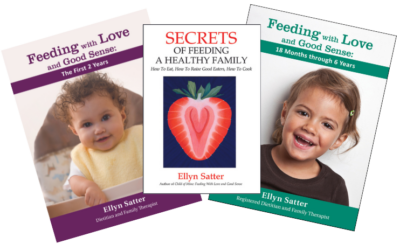Feeding with Love and Good Sense: The First Two Years © 2020
Price range: $0.00 through $840.00
A good feeding relationship with your child starts at day one and makes all the difference between joy or struggle in feeding. This brief, beautiful, compact, engaging booklet gets today’s busy parents off to a good and authoritative start with feeding.
Raise a healthy child who is a joy to feed. Ellyn Satter, leading authority on child nutrition and feeding, tells you how. Focus on rewarding family meals and nurturing your child’s positive feelings about eating, not on what or how much s/he eats. Your child will grow well and, sooner or later, eat almost everything you eat. This beautiful and engaging booklet helps you recognize and understand stages in development, trust and enjoy your child, choose developmentally and nutritionally appropriate food, and parent in the best way. Tells what to do in words and pictures, and shows why to do it with examples and feeding stories from other parents. Feeding with Love and Good Sense: 18 Months through 6 Years provides supportive, concise, accessible, and authoritative parent guidance relative to feeding and parenting. Appropriate for medical and educational settings, health care, public health, mental health, and public service.
- 6th grade reading level.
- 40 pages
- Full color, photos
- 7.5 by 11 inches
Want thousands of this booklet? Contact us about a dedicated print run branded with your logo.
Table of Contents
- Where you are going with feeding. Think of your child as a future toddler. By 8 to 18 months, your tiny baby will be a good eater and ready to join in when you have family-friendly meals.
- Follow the division of responsibility. To raise a good eater, do your jobs with feeding and parenting, then trust your child to do her jobs with eating, moving, and growing.
- Understand your child’s development and temperament. Being able to recognize stages in development and understand temperament lets you trust and enjoy your child and parent in the best way.
- How to feed your newborn and infant. Your baby eats best and feels best about you—and about eating—when you pay attention to her and do what she wants.
- How to feed your older baby and toddler. Start and progress solid foods based on what your baby can do, not how old he is. Rules about when and what to feed make you ignore your baby and doubt your judgment.
- What to feed your child: step by step. Your child might progress from starting solids to joining in with family meals in a couple of months, or it may take a year or more. Go as fast or as slowly as is right for her.
- Solve feeding problems. To correct feeding problems, be sure to do your jobs and just as sure to refrain from trying to do your child’s jobs. Focus on the quality of feeding rather than the quantity your child eats.
- What you have learned. Feeding is parenting in all ways. You have to do your jobs, but then you have to let go. Throughout the growing-up years, maintain a division of responsibility in feeding.
Additional information
| Weight | 13 lbs |
|---|---|
| Dimensions | 10 × 11 × 12 in |



Julie Drzewiecki –
Best Infant Feeding Book In The World
As a Registered Dietitian who provides nutrition counseling to pregnant women with gestational diabetes and to parents of babies and children, I am here to testify this is the best infant feeding book. I nagged my boss incessantly until he let me provide copies to my patients. My patients LOVE this resource. The OB/GYN’s I work with LOVE this resource for their patients. My boss now realizes that provided these books to our patients was a great public relations coupe for our hospital. Don’t wait! Buy your copy today!